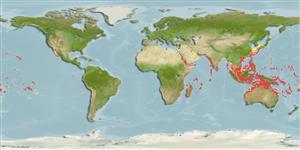Malacostraca |
Decapoda |
Carpiliidae
Environment: milieu / climate zone / depth range / distribution range
Ecology
Reef-associated; depth range 0 - 95 m (Ref. 96667). Tropical; 37°N - 32°S, 30°E - 108°W
Indo-Pacific: from Japan, Hawaii and the Red Sea south to South Africa and Mozambique, west to Eastern Africa and east to French Polynesia and Easter Island.
Length at first maturity / Size / Weight / Age
Maturity: Lm ? range ? - ? cm Max length : 15.0 cm CW male/unsexed; (Ref. 343)
Carapace ovate; dorsal surface very smooth and convex. Color: uniform red to reddish brown, with irregular dark brown patches on the dorsal surface of carapace (Ref. 343). Pincers are stout and unequal in size (Ref. 128968).
Found under stones or cracks in coral reefs (Ref. 128968). Collected extensively for food in some areas (Ref. 343). May contain toxins that are undectectable in tests (Ref. 107779), and thus, may not be safe to eat (Ref. 128968). Found in the littoral to sublittoral zones (Ref. 77016). On rocky outcrops or coral reefs sheltering in crevices or under stones (Refs. 801, 9773). Reported to be mildly toxic (Ref. 103037). Benthic carnivore (Ref. 107079). Preys on tridacnids (Ref. 108392). Opportunistic scavenger. Feeds on plant material to benthic invertebrates (Ref. 9773).
Life cycle and mating behavior
Maturity | Reproduction | Spawning | Eggs | Fecundity | Larvae
Members of the order Decapoda are mostly gonochoric. Mating behavior: Precopulatory courtship ritual is common (through olfactory and tactile cues); usually indirect sperm transfer.
Ng, P.K.L. 1998. (Ref. 343)
IUCN Red List Status (Ref. 130435)
CITES status (Ref. 108899)
Not Evaluated
Not Evaluated
Threat to humans
Poisonous to eat (Ref. 128968)
Human uses
Fisheries: commercial
| FishSource | Sea Around Us
Tools
More information
Age/SizeGrowthLength-weightLength-lengthMorphologyLarvaeAbundance
Internet sources
Estimates based on models
Preferred temperature
(Ref.
115969): 24.5 - 29, mean 27.9 (based on 1594 cells).
Vulnerability
Low vulnerability (10 of 100).
Price category
Unknown.
Nutrients: Calcium = 109 [35, 184] mg/100g; Iron = 1.59 [1.21, 1.97] mg/100g; Protein = 20.2 [19.2, 21.3] %; Omega3 = 0.285 [0.185, 0.386] g/100g; Selenium = 48.3 [-31.7, 128.3] μg/100g; VitaminA = 0 μg/100g; Zinc = 1.79 [1.17, 2.40] mg/100g (wet weight).
